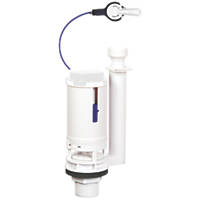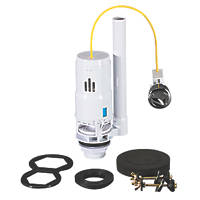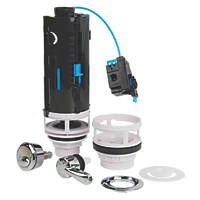We’d like to remind Forumites to please avoid political debate on the Forum.
This is to keep it a safe and useful space for MoneySaving discussions. Threads that are – or become – political in nature may be removed in line with the Forum’s rules. Thank you for your understanding.
📨 Have you signed up to the Forum's new Email Digest yet? Get a selection of trending threads sent straight to your inbox daily, weekly or monthly!
Why won't my toilet flush every time?
adougl16
Posts: 20 Forumite






My toilet flushes about 5 times and then won't flush. I have to then either adjust the handle or repeat the flushing motion several times.
The old handle was loose and the toilet would flush when I tightened it, however after a few uses it would stop working. I replaced the handle, but it only worked for about a day. I've tried adjusting the handle so that the metal "hook" is at various lengths/angles, but every time it works for a few flushes and then stops.
What am I doing wrong?

0
Comments
-
The most usual reason for erratic flushing is the diaphragm washer inside the flush syphon. This is a thin sheet of polythene, supported on some sort of (usually) plastic mesh. When you depress the handle, it lifts this diaphragm, pulls water into the syphon which goes over the internal pipe and creates a syphon of water which runs until (nearly) all the water in the cistern has been transferred into the pan.
These washers go hard with age, then crack and break. The syphon then works only when the bits happen to meet / overlap and create the vacuum again.
The remedy is to change the diaphragm washer. However, this means removing the syphon. In your case this is the bit with the green plastic top. If you have a low level close coupled WC (i.e. one where the cistern is directly on the back of the pan), this also means removing the cistern. When putting it back together you need not only the new diaphragm washer (which you can cut out yourself from a sheet of fairly thick PVC) but a new "close coupling kit" with what is called a "doughnut" washer. The doughnut washer is a thick rubber washer which seals the cistern to the pan.
If you do decide to do this, I'd advise replacing the whole syphon mechanism with a Dudley "Turbo 88". This enable you to replace the diaphragm washer in future without taking the WC to bits.6 -
I had this recently and had the diaphragm changed; then the weight of the water on the diaphragm was too much for the rest of the system so I ended up having a completely new flush mechanism put in. It cost £150 altogether.3
-
Definitely needs a new siphon. The Dudley is a good suggestion but you can get a Viva Skylo from Toolstation for half the price. If you are going to do it yourself make sure the new siphon looks like it will fit before starting as it's a pain if they are a bit too big and catch the side of the cistern and buy a new close coupled kit too.Sorry I can't think of anything profound, clever or witty to write here.2
-
Whiterose23 said:I had this recently and had the diaphragm changed; then the weight of the water on the diaphragm was too much for the rest of the system so I ended up having a completely new flush mechanism put in. It cost £150 altogether.
K' what now. When was this, what's with the prices. I assume it is 99% labour! I put in a new toilet when I moved house 6 years ago and the old one was useless. It cost £60 complete and had everything in the cistern already in place just ready to put together! (plumbing is easy, the places you have to do it in are not!).
1 -
Changing the flush mechanism is an easy DIY job. It might take a couple of hours the first time you do it, and you might need to buy a £10 tool, but to save £60-£150, it’s worth learning to do. They are instructional videos on YouTube.The comments I post are my personal opinion. While I try to check everything is correct before posting, I can and do make mistakes, so always try to check official information sources before relying on my posts.1
-
-
tacpot12 said:Changing the flush mechanism is an easy DIY job. It might take a couple of hours the first time you do it, and you might need to buy a £10 tool, but to save £60-£150, it’s worth learning to do. They are instructional videos on YouTube.It's worth changing this outdated thing from the past to something more modern, convenient and dual-flash.E.g.
2 -
Blimey you have been well done !!Whiterose23 said:I had this recently and had the diaphragm changed; then the weight of the water on the diaphragm was too much for the rest of the system so I ended up having a completely new flush mechanism put in. It cost £150 altogether.
Parts from Toolstation or Screwfix would have been under £20.
1 -
Now and again items need some service, as already mentioned the siphon could be repaired or the siphon exchanged. Recommend the siphon is exchanged.
Its a straight forward for a plumber, the cistern to wall securing screws look corroded away and some grit seems to be sitting in the bottom of the cistern.
Assuming its just the siphon, Just half an hours work for a plumber Choose Stabila !0
Choose Stabila !0 -
1. If I were you I wouldn't go anywhere near a flush valve type. Water can't get past a syphon if it is faulty. With a flush valve you can get leaks which can go undetected for months. Very expensive if you are on a water meter.
2. Anyone who can get two rusted screws out of the wall, two further rusty screws off from the close coupling kit, remove and clean the cistern, clean the joint on the pan, replace the close coupling kit, replace the syphon, reassemble everything test it and finish in half an hour has achieved a miracle. To say nothing of replacing the isolation valve (if any) when it leaks after being used.0
Confirm your email address to Create Threads and Reply

Categories
- All Categories
- 352.9K Banking & Borrowing
- 253.9K Reduce Debt & Boost Income
- 454.7K Spending & Discounts
- 246K Work, Benefits & Business
- 602K Mortgages, Homes & Bills
- 177.8K Life & Family
- 259.9K Travel & Transport
- 1.5M Hobbies & Leisure
- 16K Discuss & Feedback
- 37.7K Read-Only Boards




 https://www.youtube.com/watch?v=ghynZEJXbfQ
https://www.youtube.com/watch?v=ghynZEJXbfQ


